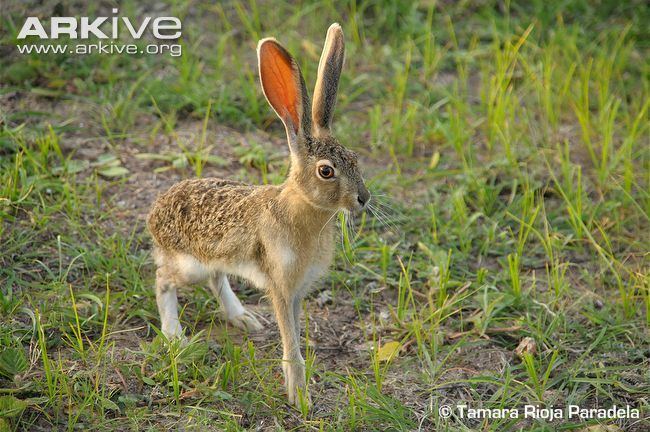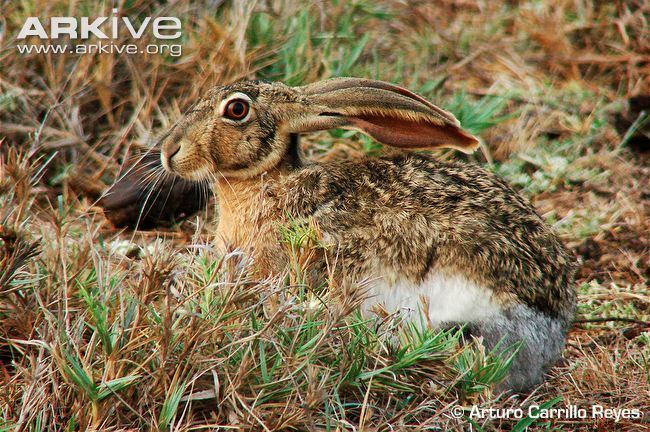Genus Lepus Higher classification Hare | Phylum Chordata Scientific name Lepus flavigularis Rank Species | |
 | ||
Similar White‑sided jackrabbit, Hare, Black jackrabbit, Ethiopian hare, Yunnan hare | ||
The Tehuantepec jackrabbit (Lepus flavigularis) is easily distinguished from other species of jackrabbits by two black stripes that run from the base of the ears to the nape, and by its white flanks. Underparts are white, upperparts are bright-brown washed with black, rump is gray, and the tail is black. This leporid is one of the largest jackrabbits and has large ears and legs. Adults weigh about 3500 to 4000 grams.
Contents

Distribution

The Tehuantepec jackrabbit is a rare endemic of Oaxaca, México, and is only found along savannas and grassy dunes on the shores of a salt water lagoon connected to the Gulf of Tehuantepec. Three small populations persist isolated from each other.

The former distribution of the Tehuantepec jackrabbit is not documented in detail, but it is estimated that the leporid's historic geographic range along the Mexican Pacific Coast on the Isthmus of Tehuantepec from Salina Cruz in Oaxaca to Tonalá in Chiapas, an area of perhaps only 5000 km sq.
Habitat and Ecology
Tropical dry savannas dominated by native grasses (Bouteloua, Paspalum) with an overstory of sparse bushes of nanche (Byrsonima crassifolia), and scattered trees of morro (Crescentia) are selected by the Tehuantepec jackrabbit. The Tehuantepec Jackrabbit is also found in coastal grassy dunes with Opuntia decumbens, Opuntia tehuantepecana, and Sabal mexicana.

Home ranges overlap with one or more individuals regardless of sex and age, and home range size is about 50 ha with core areas of 9 ha for adult jackrabbits. The Tehuantepec jackrabbit is nocturnal and crepuscular, and during the diurnal hours it rests in forms under bushes or grasses.
Native mammals that coexist with the Tehuantepec jackrabbit are the eastern cottontail (Sylvilagus floridanus), the nine-banded armadillo (Dasypus novemcinctus), the hooded and western hog-nosed skunks (Mephitis macroura, Conepatus mesoleucus), the Virginia opossum (Didelphis marsupialis), the gray mouse opossum (Tlacuatzin canescens), the gray fox (Urocyon cinereoargenteus), the common raccoon (Procyon lotor), and the coyote (Canis latrans). Of these, the gray fox and the coyote are native predators of the Tehuantepec jackrabbit.
Reproduction
The length of the breeding season may extend from February to December, with a peak in reproduction during the rainy season (from May to October). Litter size is one to four embryos, but the number of litters produced per female per year remains to be investigated.
Conservation
The Tehuantepec jackrabbit is listed as critically endangered in the Mexican Official Norm NOM-059-ECOL-2001, and as an endangered species by the International Union for the Conservation of Nature (IUCN) Red List of Endangered Species.
Threats
The Tehuantepec jackrabbit is jeopardized by habitat loss and fragmentation, poaching, small population size, and genetic isolation. Introduction of exotic grasses, frequent and induced fires, agricultural and cattle-raising activities, and human settlements are deteriorating the floristic diversity and native vegetation structure in savannas inhabited by Tehuantepec jackrabbits. Locally, the Tehuantepec jackrabbit is taken occasionally as subsistence hunting, and very occasionally as pets in rural communities. Predation by the Gray Fox and the Coyote is the major cause of mortality of the Tehuantepec Jackrabbit. However, poachers may come from nearby cities and decimate populations in a few nights of hunting.
